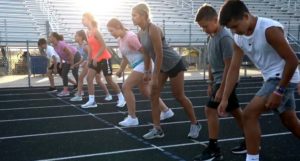Originally published July 8, 2022 by the Globe and Mail of Canada.
By Josh Fullan
Here’s a grim consideration: today’s Canadian teenagers may have some of the lowest physical activity levels of any peer group in history.
In a study of more than 10,000 Ontario families that I led between the spring and early summer of last year, just 2.8 per cent of youth aged 12 to 17 met the Canadian Society for Exercise Physiology’s guidelines for physical activity and recommendations for outdoor play. Almost a third went through the week without ever achieving the optimal daily hour of energetic physical activity – the kind of sweaty movement that gets the heart pumping and packs maximum health benefits, including peak brain performance.
 Part of this trend is a hangover from the COVID-19 pandemic, but much of it predates that first pestilential spring. After all, Ontario is home to more than 600,000 high school students who are required to earn a grand total of one Health and Physical Education credit for their diploma. In practical terms, this means a student can take a physical education class in the first semester of grade nine then never take one again, which is exactly what many do. Sports programs can fill the activity gap, but only for some.
Part of this trend is a hangover from the COVID-19 pandemic, but much of it predates that first pestilential spring. After all, Ontario is home to more than 600,000 high school students who are required to earn a grand total of one Health and Physical Education credit for their diploma. In practical terms, this means a student can take a physical education class in the first semester of grade nine then never take one again, which is exactly what many do. Sports programs can fill the activity gap, but only for some.
It would be easy to thus conclude that students simply aren’t interested in physical education, or fall into old tropes about lazy adolescents sloughing off what’s good for them. The twin bogeymen of video games and social media are surely to blame, too. But the truth is more complex. Systems set priorities and values. In our schools, this top-down approach can lead to a narrow focus on achievement in numeracy, literacy, and science at the expense of other competencies, including the physical; show me your diploma requirements, and I’ll tell you what the school system values.
So for too many high school students, crafting a course calendar is a zero-sum game. Taking physical education might mean having to miss out on an elective they are passionate about, or forgoing a credit required for post-secondary pursuits. Students might also worry about how a low grade in physical education might affect their overall average. Those with body-image or self-esteem issues will avoid it, too. None of these pressures align with what needs to be a goal of every teenager: getting exercise for health’s sake on the road to building an active lifestyle.
There is a false paradigm here, however: that (PE) class and good grades are mutually antagonistic. In fact, research has shown that physical activity is a ballast for academic performance, not an anchor. The Naperville Zero Hour study, highlighted in Harvard psychiatrist John Ratey’s book Spark, details how the Illinois school district leveraged early morning aerobic exercise into top academic test scores, not to mention happier, more engaged students. Closer to home, some schools have adopted their own daily physical activity programs for secondary students; provinces like British Columbia and Manitoba require more than the single physical education credit to graduate.
Recently, schools have taken more responsibility for the well-being of students, a seemingly complementary focus partly driven by the alarming increase in student mental health concerns and by a deeper understanding that learning doesn’t flourish without purpose and belonging. Yet the potential of this new focus is wasted without connecting the dots between physical and mental health.
Physical activity has been shown to increase a sense of self-efficacy and reduce depression, anxiety, stress, loss of control – the very challenges many young folks are struggling with. Whether we are emerging from the pandemic or entering a new wave, the greatest act of care that schools can provide might be to ensure that students all participate in physical activity, so they can see the benefits themselves.
Making physical education classes mandatory is one way to do so. Another way is to make physical activity the responsibility of the entire school by incorporating movement into active school travel and various classes: neighbourhood walks in the social sciences, say, or dance and improv in drama class. Parents should be active with their kids, too, and encourage them. It is also important that schools don’t grade all physical activity: Make it skill-building and developmental as appropriate, but remove the stakes – or, as they did in Naperville, assess students based on effort.
Our schools need to teach fitness, not sports; they need to ensure every teenager gets a minimum daily amount of quality physical activity, preferably early in the day. They need to make it social and inclusive. Above all, they should show students what they value by telling them why it is a priority: because the best evidence says physical activity supports their learning, health, and happiness like nothing else we know of.
Josh Fullan is the director of Maximum City, a national education and engagement organization.
Make the IHT ZONE heart rate monitor part of your School’s Student Wellness Program
[contact-form-7 id=”27996″ title=”Contact Us Single Column”]


